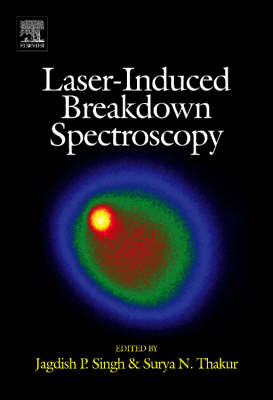
Laser-Induced Breakdown Spectroscopy
Elsevier Science Ltd (Verlag)
978-0-444-51734-0 (ISBN)
- Titel erscheint in neuer Auflage
- Artikel merken
Laser induced breakdown spectroscopy (LIBS) is basically an emission spectroscopy technique where atoms and ions are primarily formed in their excited states as a result of interaction between a tightly focused laser beam and the material sample. The interaction between matter and high-density photons generates a plasma plume, which evolves with time and may eventually acquire thermodynamic equilibrium. One of the important features of this technique is that it does not require any sample preparation, unlike conventional spectroscopic analytical techniques. Samples in the form of solids, liquids, gels, gases, plasmas and biological materials (like teeth, leaf or blood) can be studied with almost equal ease. LIBS has rapidly developed into a major analytical technology with the capability of detecting all chemical elements in a sample, of real- time response, and of close-contact or stand-off analysis of targets. The present book has been written by active specialists in this field, it includes the basic principles, the latest developments in instrumentation and the applications of LIBS . It will be useful to analytical chemists and spectroscopists as an important source of information and also to graduate students and researchers engaged in the fields of combustion, environmental science, and planetary and space exploration.
Dr. Singh received his M.Sc. and PhD from Banaras Hindu University, India. His field of specialization is Laser Spectroscopy, Optical Fiber Sensors, Explosive detection, Molecular Dynamics, Laser Diagnostics for Combustion, Laser Ultrasonic and Hazardous Waste Management. Dr. Singh is currently working on laser-based advanced optical diagnostics such as Laser Induced Breakdown Spectroscopy (LIBS) for measuring the composition of the Plutonium Oxide residue produced during weapons-grade Plutonium processing. He has developed LIBS for measuring the concentration of toxic metals in the off-gases and in melt glass. Dr. Singh has worked in laser photo fragmentation laser induced fluorescence (PF-LIF) to measure the concentration of explosives. Dr. Singh has also developed Non-linear laser diagnostic techniques such as Coherent Anti-Stokes Raman Spectroscopy for high temperature, high luminescence and turbulent combustion flows. He has published 165 papers in International Journals, 176 presentations and 8 patents. Dr. Singh is Fellow of OSA and LASSI. Surya N. Thakur is a retired Professor of Physics at Banaras Hindu University, India. He has taught courses in Physical Optics, Atomic Spectroscopy, Electronic & Vibrational Spectroscopy of Molecules, Spectro-Chemical Analysis, Lasers & Nonlinear Spectroscopy, Molecular Vibrations & Nonradiative Transitions and Experimental Techniques of Supersonic Molecular Beam Spectroscopy, Photoacoustic & Photothermal Spectroscopy, Optogalvanic Spectroscopy, and Raman Spectroscopy. He received his PhD in Experimental Spectroscopy from Banaras Hindu University and carried out postdoctoral work at Reading University, UK and SUNY Binghamton, USA. His interests are nonlinear spectroscopy, potential surfaces and nonradiative transitions in large molecules. He has held 1851 Exhibition Fellowship of the Royal Commission (London) and the Career Award of the University Grants Commission (New Delhi, India). He was President of the Physics Section of Indian National Science Congress in 1991 and is a Fellow of the Laser and Spectroscopy Society of India. He has over 100 research publications.
PART I : BASIC PHYSICS & INSTRUMENTATION
1. Fundamentals of LIBS (S. N. Thakur and J. P. Singh)
2. Atomic Emission Spectroscopy (S. N. Thakur)
3. Laser Ablation (R. E. Russo, X. L. Mao, J. Yoo and J. J. Gonzalez)
4. Physics of Plasma in LIBS (V. N. Rai and S. N. Thakur)
5. Instrumentation for LIBS (V. N. Rai and S. N. Thakur)
PART II: NEW LIBS TECHNIQUES
6. Dual Pulse LIBS (J. Scaffidi, D. A. Cremers and S. M. Angel)
7. Femtosecond LIBS (M. Sabsabi)
8. Micro LIBS (M. T. Taschuk, I. V. Cravetchi, Y. Y. Tsui and R. Fedosejevs)
PART III: LIBS APPLICATIONS
9. LIBS Application to off-Gas Measurement (F. Y. Yueh and J. P. Singh)
10. LIBS of Liquid Samples (V. N. Rai, F. Y. Yueh and J. P. Singh)
11. LIBS of Solid and Molten Material (A. K. Rai, F. Y.Yueh, J. P. Singh and D. K. Rai)
12. LIBS of Powder Materials (B. Lal, L.St-Onge, F.Y. Yueh and J. P. Singh)
13. LIBS for the Analysis of Chemical and Biological Hazards (S.G. Buckley)
14. Life-Science Applications of LIBS (F. Y. Yueh, A. Kumar and J. P. Singh)
15. Measurement of Carbon for Carbon Sequestration and Site Monitoring (M. Z. Martin, S. D. Wullschleger, C. T. Garten Jr., and A. V. Palumbo)
16. Remote Analysis by LIBS: Application to Space Exploration (D. A. Cremers)
17. LIBS for Aerosol Analysis (D.W. Hahn and U. Panne)
18. Scope of Future Development in LIBS (J. P. Singh and F. Y. Yueh)
| Erscheint lt. Verlag | 3.10.2007 |
|---|---|
| Verlagsort | Oxford |
| Sprache | englisch |
| Gewicht | 980 g |
| Themenwelt | Naturwissenschaften ► Chemie ► Analytische Chemie |
| ISBN-10 | 0-444-51734-0 / 0444517340 |
| ISBN-13 | 978-0-444-51734-0 / 9780444517340 |
| Zustand | Neuware |
| Haben Sie eine Frage zum Produkt? |
aus dem Bereich


